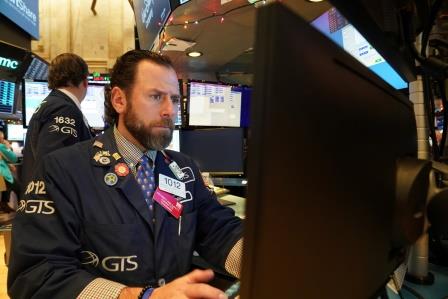NEW YORK- The dollar slid on Monday, and global stock markets fell as a year-end rally lost steam after pushing stocks to record highs in 2019.
As investors assessed the outlook for next year, thin year-end trading volumes exacerbated broad weakness in the dollar, which has fallen the past three sessions. On Friday, it notched its biggest daily decline since March.
Germany’s 10-year bond yield hit a seven-month high and U.S. Treasury yields rose, driving the yield curve between two- and 10-year notes to its steepest in 14 months on expectations the Federal Reserve will not lower rates.
Wall Street slid as did equity markets in Europe and Japan, but overnight Chinese blue chips closed at an eight-month high and shares in Hong Kong closed at more than a five-month peak after China’s central bank moved to lower funding costs.
MSCI’s gauge of stocks across the globe shed 0.43%, while the pan-European STOXX 600 index lost 0.85%. Both hit all-time highs on Friday.
Stocks on Wall Street fell in their biggest one-day decline in four weeks after a record run. The benchmark S&P 500 had logged record closes in nine of the previous 11 sessions and is up four months in a row.
News on the U.S.-China trade deal failed to lift markets as it had in past sessions. White House trade adviser Peter Navarro said the pact was likely to be signed in the next week, and the South China Morning Post earlier reported Chinese Vice Premier Liu would travel to Washington later this week to sign the deal.
“This is just end-of-year rally fatigue,” said Kristina Hooper, chief global market strategist at Invesco in New York. “It makes sense that investors are taking their foot off the gas for the last two days of the year.”
The Dow Jones Industrial Average fell 183.12 points, or 0.64%, to 28,462.14. The S&P 500 lost 18.73 points, or 0.58%, to 3,221.29 and the Nasdaq Composite dropped 60.62 points, or 0.67%, to 8,945.99.
Monetary policy, including three rate cuts by the Fed, was the dominant factor for markets in 2019 and will likely be next year, too, as central banks remain accommodative, Hooper said.
“That certainly helped markets,” she said, but more for emerging markets than in developed markets.
Emerging market stocks lost 0.02%, with the Mexican bolsa tumbling 1.79%, but are likely to outperform other equity markets in 2020, Hooper said.
“This is going to be a year of EM, in particular Asia EM, and that certainly includes Chinese equities,” she said.
Chinese stocks were beaten down for much of 2019 on the notion China would lose the U.S.-Sino trade dispute, she said.
The Fed has aggressively increased the amount of dollars in circulation, pushing so-called M2 money supply growth to 7.6% year over year last month from 3.2% in November 2018, according to Dick Bove, senior research analyst at Odeon Capital Group.
The dollar index, which measures the currency against a basket of six major trading rivals, fell 0.16%, with the euro up 0.24% to $1.1202.
The Japanese yen strengthened 0.59% versus the greenback at 108.85 per dollar.
Benchmark 10-year notes fell 4/32 in price to yield 1.8858%. Two-year notes yielded 1.5732%, a spread of about 31 basis points. In August the yield curve had inverted, a sign a recession was likely in a year or two.
A steeper yield curve also suggests investors are optimistic that the U.S. economy won’t slow as much as expected.
Germany’s 10-year bond yield rose as high as -0.174% <DE10YT=RR> on optimism over U.S.-China trade and the global growth outlook, which was tainted for much of 2019 by fears the trade war would push the world into recession.
Gold prices gained, helped by hedging against a potential spike in inflation next year or potential geopolitical risk, Hooper said.
Spot goldadded 0.3% to $1,514.74 an ounce, while U.S. gold futures settled unchanged at $1,518.60.
Oil prices rose to three-month highs, boosted by trade hopes and upbeat industrial data, while traders kept a close watch on the Middle East following U.S. air strikes in Iraq and Syria.
Brent crude futures gained 28 cents to settle at $68.44 a barrel. West Texas Intermediate (WTI) crude futures settled down 4 cents at $61.68 a barrel.
(Content and photos syndicated via Reuters)













